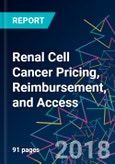REGULATORY LABELS
Marketed renal cell cancer products in the US, Japan, and five major EU markets
Bibliography
GLOBAL ACCESS LEVERS
Expenditure on RCC medicines poses a moderate concern for payers
Pipeline compounds, and particularly combinations, have some payers concerned
Access to RCC medicines is subject to mild restrictions
Contracting is expected to be used more widely in the future
Combination treatments may present a particular challenge in the future, especially if developed by different manufacturers
EVIDENCE AND VALUE
Importance of RCC clinical trial endpoints in the US and five major EU markets
Median overall survival remains the gold standard endpoint for RCC
Complete response rate is valued by physicians, but not by payers
Quality of life is mostly tied to safety, but can support added benefit assessments in some markets
Safety differences among products could impact HTA evaluations, and differences in hospitalizations are most relevant for payers
UK payers prefer clinical trials with strict stopping criteria, while others continue to focus on pricing to manage costs
Presenting evidence of value along the entire treatment pathway through sequencing studies would be valued, especially for combinations
Biomarker stratification will be critical for optimizing placement in the future treatment agorithm
Bibliography
ACCESS TO RECENTLY APPROVED AND PIPELINE DRUGS
Combination therapies Tecentriq + Avastin and Opdivo + Yervoy are likely to be reimbursed in first-line RCC
Cabometyx’s Phase II data lack power to convince payers of the added benefit over Sutent
National bodies leave the choice between second-line options Cabometyx and Opdivo to physicians
Treatments targeting the adjuvant setting continue to face a number of challenges
Price benchmarks for PD-1 inhibitors in RCC are reliant upon other approved indications
US
Insights and strategic recommendations
Bibliography
JAPAN
Insights and strategic recommendations
Japan’s pricing strategy is reliant on pricing premiums for innovative medicines
Bibliography
FRANCE
Insights and strategic recommendations
ASMR rating has an impact on pricing
Bibliography
GERMANY
Insights and strategic recommendations
Positive assessment from the G-BA will impact price negotiations
Bibliography
ITALY
Insights and strategic recommendations
Bibliography
SPAIN
Insights and strategic recommendations
National reimbursement decisions are not a major access barrier in Spain
Regional access to RCC treatments varies in Spain
Bibliography
UK
Insights and strategic recommendations
NICE approval is a key market access barrier
Bibliography
METHODOLOGY
Primary research
Price assumptions
Exchange rates
Bibliography
LIST OF FIGURES
Figure 1: Price sources and calculations for the US and five major EU markets, by country
LIST OF TABLES
Table 1: Marketed products and their approved indications for RCC in the US, Japan, and five major EU markets
Table 2: Levers impacting access to RCC drugs in the US and five major EU markets, by country
Table 3: Pricing, market access, and reimbursement strategies for combination therapies
Table 4: Importance of key endpoints in RCC clinical trial design, by country
Table 5: Likely reimbursement of first-line combination therapies in RCC, by country
Table 6: Pricing and reimbursement prospects for Cabometyx in the first line, by country
Table 7: Preference for second-line treatment: Opdivo versus Cabometyx, by country
Table 8: Pricing strategies for the PD-1 inhibitors, by country
Table 9: Pricing of key RCC drugs in the US, Japan, and five major EU markets, by country
Table 10: NCCN guidelines for RCC medicines
Table 11: Japan - pricing premiums given to medicines that can demonstrate benefit over comparators
Table 12: Price calculation methodologies for RCC drugs in Japan launched after 2008
Table 13: Transparency Committee’s ASMR ratings and pricing implications
Table 14: Transparency Committee's SMR ratings and pricing implications
Table 15: AIFA web registry and managed entry agreements for RCC drugs
Table 16: Spanish Society of Hospital Pharmacy ratings
Table 17: Exchange rates used for calculating drug prices








